Phalaenopsis stuartiana is often called the sibling of f. Schiller for the amazing resemblance and origin.
Phalaenopsis Stuartiana is known as the Moth orchid in most regions and also Stuart’s Phalaenopsis. It has many orchid species and varieties based on color and characteristics.
However, it differs from its sibling not only in the size and color of the flowers but also in many other vegetative traits.
It is uncomplicated in culture and blooms easily, which attracts the attention of collectors and orchid lovers.
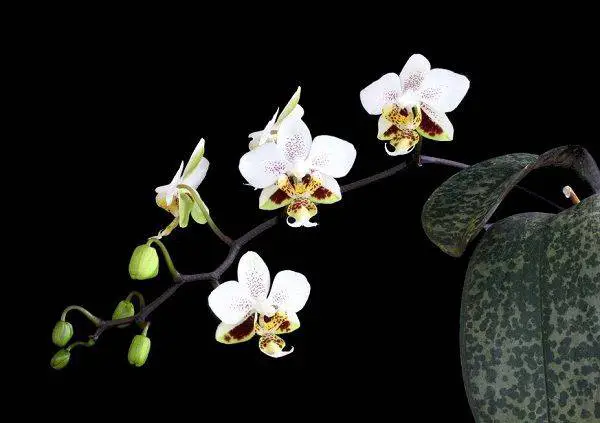
(moth orchid)
Phalaenopsis Stuartiana (Moth Orchid)
In nature, this species is endemic to the Philippine Islands and is found only on the island of Mindanao, where it grows at an altitude of up to 300 m above sea level. Plants prefer to settle in the crowns of trees.
Despite the fact that the Philippines is characterized by a short dry period, the Stuartiana phalaenopsis region not only does not have a sharp change in seasons and has warm, wet weather throughout the year, but precipitation falls fairly regularly.
The lighting level also remains constant. In such conditions, the orchid all year round, without stopping, grows new roots and leaves, and periodically blooms. Check out White Cymbidium Orchid varieties and care guide.
Phalaenopsis Stuartiana discovery history
This species was discovered by the English collector Boxall, who was searching for orchids for the firm of Hugo Low and K. The co-owner of this company was the English researcher Stuart Low, after whom this type of phalaenopsis was named.
Moth Orchid Peculiarities
The Stuartiana orchid aka Moth orchid is decorative not only because of the flowers but also because of the beautiful leaves with a marble pattern reminiscent of Schiller’s phalaenopsis.
However, the drawing is still different. The root system is usually powerful, well developed.
Interesting! The species is able to grow and bloom exclusively under artificial lighting.
moth orchid colors Varieties
In nature, in addition to plants with the traditional color of flowers, there are also Moth orchid specimens whose color is different. These plants have been classified into the following subspecies:
- phalaenopsis stuartiana var. punctatissima with particularly intense and bright color spots;
- phalaenopsis stuartiana var.Nobilis. The main color of the petals is yellow;
- phalaenopsis stuartiana var. green. Flowers have a greenish tint;
- phalaenopsis stuartiana var.bella. The lower half of the lateral sepals is colored yellow with purple stripes, and there is a large brown spot on the lip.
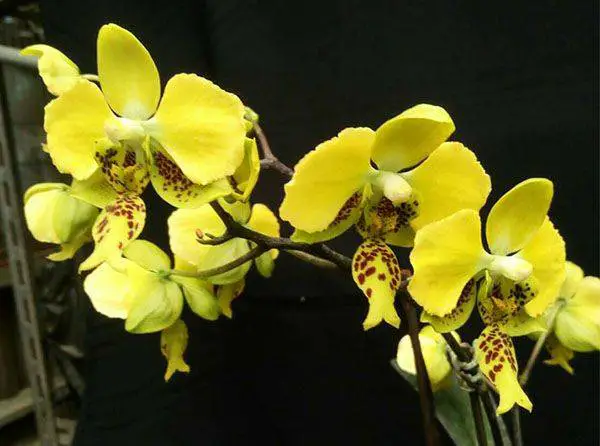
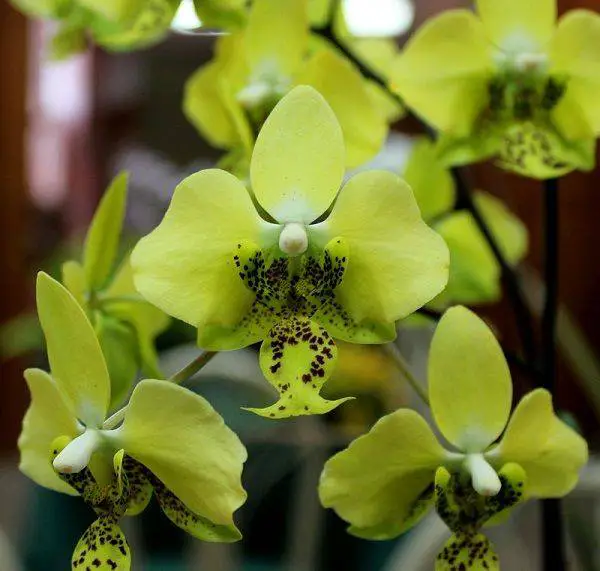
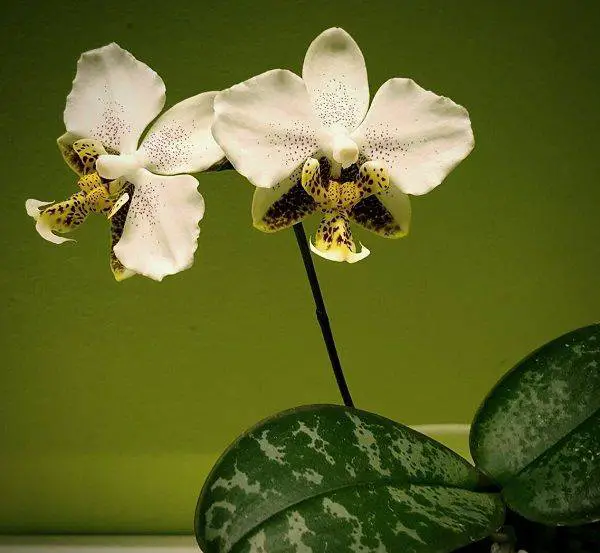
Here is guide on Two Giant Orchids and characteristics.
phalaenopsis stuartiana characteristics
Like all species of the genus, Stuartiana phalaenopsis is characterized by a strongly shortened stem, completely hidden under fleshy leaves.
An adult rosette has 3 to 5 live leaves at a time, but wild-growing specimens may have more.
The length of the leaves when kept in culture rarely exceeds 20-30 cm, with a width of 8-10 cm, but in nature, you can find specimens with leaves up to 45 cm long.
Peduncle drooping, partly branched, up to 70 cm long.
The flowers are white, with a slight aroma, up to 6 cm in diameter. At the same time, up to 100 flowers can bloom on a peduncle, but with room content, such lush flowering is almost impossible.
The species is characterized by a flower structure typical of phalaenopsis:
- sepals are elongated-oval. The upper sepals are white, the lower ones are bisected by the central vein into a white upper part and a yellow lower part with purple spots;
- diamond-shaped petals can also be decorated with a spotted pattern;
- the lip is triple, orange-white with purple or brown spots;
- the lower part of the lip has the shape of an anchor, the lateral parts are strongly arched.
Phalaenopsis Stuartiana (Moth Orchid) flower Blooming
In nature, flowering specimens can be found at any time of the year. In culture, this can only be achieved if constant conditions are created throughout the year, which is not always possible.
Most often, Moth Orchid blooms in December – March. It is believed that a kind of incentive for flowering is a short period of low temperatures in autumn when the central heating batteries have not yet been launched, but it is already cold outside and in houses.
The buds grow and bloom almost simultaneously. Flowering can last up to 30 days.
Read guide on Phalaenopsis Keiki.
Phalaenopsis Stuartiana (Moth Orchid) growing
This species can be grown in special orchid pots, mesh hanging planters or on blocks. The last 2 methods are preferable, because. imitate natural conditions as much as possible, however, planting in a pot allows you to reduce the frequency of watering, especially in the heat. Choose Best Orchid Pots For Phalaenopsis.
When choosing a pot, it is worth considering the ampelous (hanging) type of plant growth, so it is advisable to place even ordinary pots in a suspended state.
Advice! Landing on a bare-down block prevents moisture from entering and the growing point and its decay.
Soil selection
When planting in a pot, a mixture of pine bark, charcoal, and sphagnum is considered the optimal substrate. In mesh baskets that are well ventilated and dry quickly, pure sphagnum can be used.
When landing on the block, it is also recommended to make a substrate from a moisture-absorbing material. In addition, as a block, it is worth choosing massive and heavy objects that will not “tumble” under the weight of the plant.
Moth Orchid Transplant
It is not recommended to transplant Phalaenopsis the plant annually or even once every 2 years. Although a transplant after buying in a store is not only recommended but also mandatory. This will allow you to replace the substrate, inspect the roots of the plant, and carry out the necessary preventive treatment against diseases and pests.
Want to know about Phalaenopsis Tetraspis.
Phalaenopsis Stuartiana (Moth Orchid) care
Phalaenopsis Stuart can be attributed to the easy care and maintenance of species orchids. Even in an apartment, he can easily create the necessary conditions, and even a beginner can provide proper care.
The optimal conditions for keeping a plant are a combination of factors such as:
- temperature;
- humidity;
- lighting.
When it comes to the maintenance of species plants, one should always try to bring the apartment conditions as close as possible to the natural ones to which they have adapted in the process of evolution.
Temperature regime
This species belongs to orchids of warm and even hot content. Plants thrive in a temperature range of 16°C to 37°C. Lower or higher temperatures, especially in conditions of low humidity, adversely affect the growth, development of the plant, and also retard the growth of peduncles.
Moth Orchid Humidity
In nature, humidity almost all the time reaches 80-90% due to daily short-term rains. It is almost impossible to provide such a level with room content. Complete guide on humidity for phalaenopsis.
It is worth noting that plants adapt well to lower humidity and feel great at 60-70%.
However, it is necessary to monitor the balance of temperature and humidity, since at low moisture the plant is able to fix the nitrogen obtained as a result of photosynthesis only at low night temperatures.
And the probability of flowering depends on the success of the photosynthesis process.
On a note! When humidity levels are low, nitrogen fixation is best when nighttime temperatures are between 16-20°C (no higher than 24°C). Under such conditions, the peduncle may appear within two weeks.
Lighting
The light requirements of this species are very moderate. In addition, you can completely replace natural light with artificial.
When choosing the location of the plant, direct sunlight must be avoided, because. they lead to yellowing of the leaves, and the marble pattern fades. In the summer, the plant will feel good on the windowsills of the east and north orientation, and in the winter – on the south and west windows.
Lighting plays one of the most important roles for plant growth. It is necessary to maintain a constant intensity throughout the yearthen the plant will not have a dormant period and stops in growth.
When placed on a windowsill, phalaenopsis should not be exposed to direct sunlight.
Watering and fertilizing
The frequency of watering depends on the conditions of detention. The higher the air temperature and lower the humidity, the more often you will have to water the orchid.
It is advisable to use soft water for irrigation, because. sphagnum present in the substrate is highly saline and quickly decomposes under the action of ordinary tap water, which leads to the need for frequent transplants.
Topdressing during active growth is carried out every third watering, adding low concentrations of fertilizer to the water for irrigation, or by leaf.
how to encourage moth orchids to flower?
The flowering of Phalaenopsis Stuart does not depend on the presence or absence of a dormant period and is not confined to a specific time of the year.
The appearance of flower stalks primarily depends on the intensity of growth and the formation of new plant cells, for the construction of which it is necessary that the plant intensively absorb carbon dioxide from the atmosphere for the process of photosynthesis.
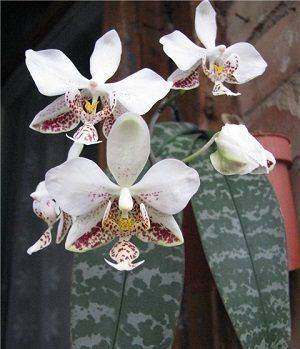
In nature, under conditions of high humidity, the process of formation of new cells goes on continuously during the day, but at low humidity, growth occurs mainly at night.
It has been established that the best absorption of carbon dioxide and the construction of new cells occurs at a temperature of 16-18°C.
Advice! Keeping Moth Orchid outdoors during the summer is the best stimulus for flowering when nighttime temperatures naturally drop to the required levels.
Moth Orchid Pruning after flowering
Often the peduncle on Moth Orchid dries completely after flowering. In this case, it is necessary to cut it as close as possible to the outlet, leaving a small stump.
But there are times when, after the flowers fall, the peduncle itself does not dry out, especially if the buds were few in number. In this case, it is worth waiting, because. the plant, after a slight stop in growth, can continue to build up the end of the peduncle and form new buds.
Prevention of diseases and pests
The main prerequisite for the occurrence of diseases and pests is a violation of the rules of care and maintenance.
To prevent the occurrence of diseases, it is necessary:
- carefully inspect new plants for damage and carry out their preventive treatment;
- new specimens should always be quarantined for at least 2 weeks;
- regularly inspect plants to notice the disease or pest at the very beginning of the defeat and protect other plants in the collection from infection.
Moth Orchid Growing problems
This view can be called unproblematic. It blooms easily, does not require special conditions of detention, and caring for it is no more difficult than for any other orchid.
The only difficulty can be called stopping the growth of the plant. This happens in cases where the conditions of detention are far from optimal.
It is recommended to constantly monitor the condition of the root growth point. When growth stops, the tip of the root is covered with a cap and freezes, leaf growth also stops.
During active growth, the root tip is olive green in color and appears brighter due to the lack of velamen on young cells.
It is especially dangerous to stop growth in winter during the operation of heating devices. The roots of a sleeping plant stop absorbing moisture, and the leaves continue to evaporate it, which can lead to loss of turgor and wilting of the leaves.
Moth Orchid Propagation methods at home
At home, the Moth orchid reproduces only vegetatively. On peduncles or from dormant stem buds, babies can develop, which can be separated from the mother plant as soon as they form their own roots and several leaves.
Differences between stuartiana phalaenopsis and Schiller’s
These species not only grow on neighboring islands under similar conditions but also have a number of common features. Some scientists even put forward hypotheses that stuartiana Phalaenopsis or Moth Orchid Propagation methods at home is a natural hybrid of Schiller’s phalaenopsis and f. Aphrodite. However, this theory has no scientific evidence.
Both species are characterized by a marble pattern on the leaves, but they have differences in pattern features, color, and size of flowers and plants. stuartiana phalaenopsis is inferior to Sheeler’s phalaenopsis in terms of leaf and flower size.
Conclusion
Phalaenopsis Stuartiana aka Moth Orchid is quite recommended for orchid lovers who are trying to bring the first species of the plant to their collection.
Unpretentious in cultivation, decorative, easy to bloom, with simple requirements for keeping conditions. This species will not cause trouble even for a novice grower.
